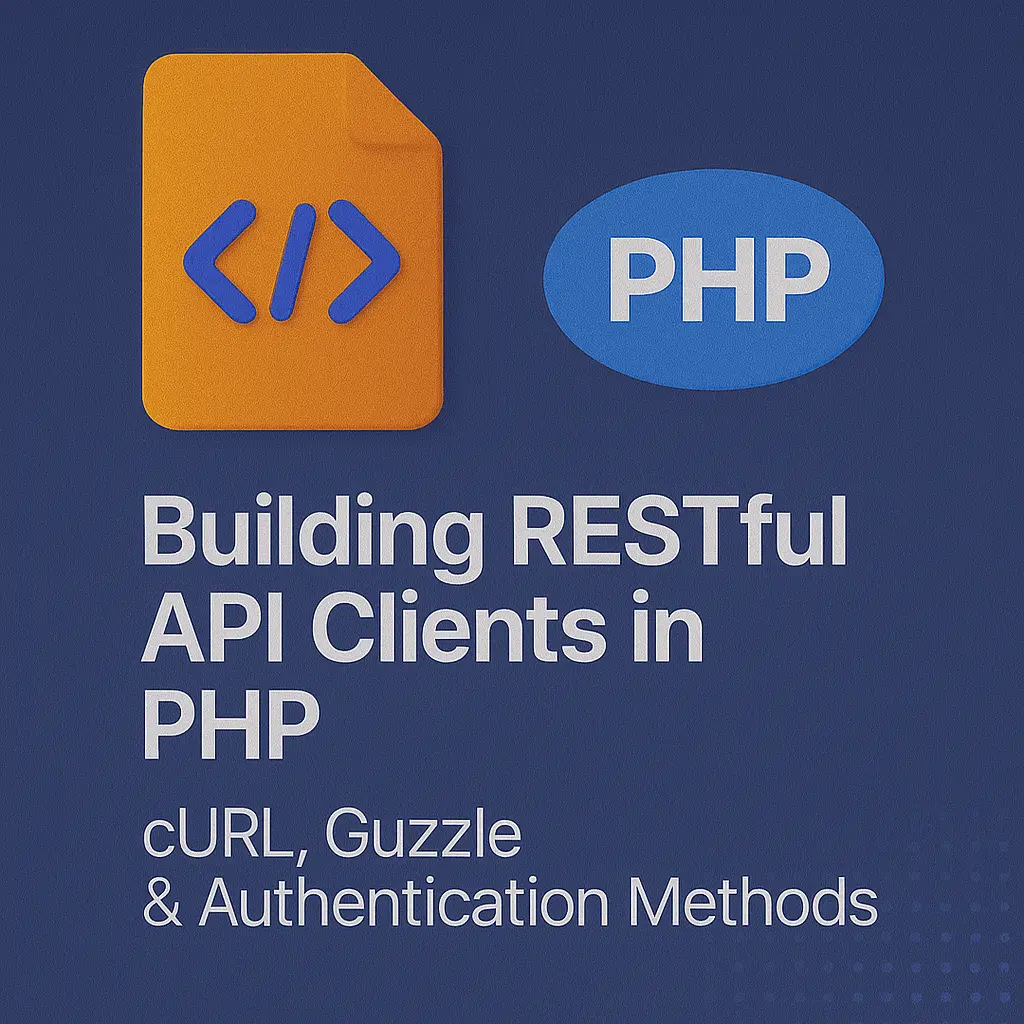Introduction to RESTful APIs
RESTful APIs (Representational State Transfer) have become the standard for web service interfaces. They allow different systems to communicate over HTTP using standard HTTP methods like GET, POST, PUT, DELETE, etc. RESTful APIs are known for their statelessness, scalability, and simplicity, making them ideal for both client-server interactions and service-oriented architectures.
In PHP, consuming RESTful APIs is straightforward thanks to various built-in functions and external libraries. This article will guide you through the process of consuming RESTful APIs in PHP and building robust API clients.
Consuming RESTful APIs in PHP
To consume RESTful APIs in PHP, we need to make HTTP requests to the API endpoints and handle the responses. PHP provides several ways to do this, including:
file_get_contents()
cURL
Guzzle (a PHP HTTP client library)
Let’s explore each of these methods with examples.
Using file_get_contents()
The file_get_contents() function is a simple way to make GET requests.
<?php
$url = "https://jsonplaceholder.typicode.com/posts/1";
$response = file_get_contents($url);
if ($response === FALSE) {
die("Error fetching the API data");
}
$data = json_decode($response, true);
print_r($data);
?>
In this example, we fetch a post from a sample API and decode the JSON response into a PHP array using json_decode().
Using cURL
cURL is a more flexible and powerful option for making HTTP requests.
<?php
$url = "https://jsonplaceholder.typicode.com/posts/1";
$ch = curl_init();
curl_setopt($ch, CURLOPT_URL, $url);
curl_setopt($ch, CURLOPT_RETURNTRANSFER, 1);
$response = curl_exec($ch);
if (curl_errno($ch)) {
die('Error: ' . curl_error($ch));
}
curl_close($ch);
$data = json_decode($response, true);
print_r($data);
?>
With cURL, we can easily customize the request by setting various options using curl_setopt(). This makes cURL suitable for handling more complex scenarios, such as sending POST requests with payloads or setting headers.
Using Guzzle
Guzzle is a PHP HTTP client library that simplifies HTTP requests and integrates well with modern PHP applications.
Installing Guzzle
You can install Guzzle using Composer:
composer require guzzlehttp/guzzle
Making GET Requests with Guzzle
<?php
require 'vendor/autoload.php';
use GuzzleHttp\Client;
$client = new Client();
$response = $client->request('GET', 'https://jsonplaceholder.typicode.com/posts/1');
$data = json_decode($response->getBody(), true);
print_r($data);
?>
Guzzle abstracts away much of the complexity involved in making HTTP requests, providing a clean and simple API for working with HTTP.
Making POST Requests with Guzzle
<?php
require 'vendor/autoload.php';
use GuzzleHttp\Client;
$client = new Client();
$response = $client->request('POST', 'https://jsonplaceholder.typicode.com/posts', [
'json' => [
'title' => 'foo',
'body' => 'bar',
'userId' => 1
]
]);
$data = json_decode($response->getBody(), true);
print_r($data);
?>
Building API Clients with PHP
Building an API client involves creating a reusable class or library that abstracts the details of interacting with a specific API. This not only simplifies the process of making API requests but also ensures consistency and reusability across your application.
Let’s build a simple API client for the JSONPlaceholder API, a fake online REST API for testing and prototyping.
Step 1: Setting Up the Client Class
We’ll create a class that uses Guzzle to interact with the JSONPlaceholder API.
<?php
require 'vendor/autoload.php';
use GuzzleHttp\Client;
class JsonPlaceholderClient {
private $client;
private $baseUri = 'https://jsonplaceholder.typicode.com/';
public function __construct() {
$this->client = new Client(['base_uri' => $this->baseUri]);
}
public function getPost($id) {
$response = $this->client->request('GET', "posts/{$id}");
return json_decode($response->getBody(), true);
}
public function createPost($title, $body, $userId) {
$response = $this->client->request('POST', 'posts', [
'json' => [
'title' => $title,
'body' => $body,
'userId' => $userId
]
]);
return json_decode($response->getBody(), true);
}
public function updatePost($id, $title, $body, $userId) {
$response = $this->client->request('PUT', "posts/{$id}", [
'json' => [
'title' => $title,
'body' => $body,
'userId' => $userId
]
]);
return json_decode($response->getBody(), true);
}
public function deletePost($id) {
$response = $this->client->request('DELETE', "posts/{$id}");
return $response->getStatusCode() === 200;
}
}
?>
Step 2: Using the Client Class
Now, let’s use our JsonPlaceholderClient class to interact with the API.
<?php
require 'JsonPlaceholderClient.php';
$client = new JsonPlaceholderClient();
// Fetch a post
$post = $client->getPost(1);
print_r($post);
// Create a new post
$newPost = $client->createPost('foo', 'bar', 1);
print_r($newPost);
// Update a post
$updatedPost = $client->updatePost(1, 'updated title', 'updated body', 1);
print_r($updatedPost);
// Delete a post
$isDeleted = $client->deletePost(1);
echo $isDeleted ? "Post deleted successfully" : "Failed to delete post";
?>
In this example, we create an instance of JsonPlaceholderClient and use its methods to fetch, create, update, and delete posts. This demonstrates how our client class abstracts the complexity of making API requests, providing a simple interface for interacting with the API.
Handling Errors
To make our client more robust, we should handle errors that may occur during API requests.
<?php
require 'vendor/autoload.php';
use GuzzleHttp\Client;
use GuzzleHttp\Exception\RequestException;
class JsonPlaceholderClient {
private $client;
private $baseUri = 'https://jsonplaceholder.typicode.com/';
public function __construct() {
$this->client = new Client(['base_uri' => $this->baseUri]);
}
public function getPost($id) {
try {
$response = $this->client->request('GET', "posts/{$id}");
return json_decode($response->getBody(), true);
} catch (RequestException $e) {
echo "Error: " . $e->getMessage();
return null;
}
}
public function createPost($title, $body, $userId) {
try {
$response = $this->client->request('POST', 'posts', [
'json' => [
'title' => $title,
'body' => $body,
'userId' => $userId
]
]);
return json_decode($response->getBody(), true);
} catch (RequestException $e) {
echo "Error: " . $e->getMessage();
return null;
}
}
public function updatePost($id, $title, $body, $userId) {
try {
$response = $this->client->request('PUT', "posts/{$id}", [
'json' => [
'title' => $title,
'body' => $body,
'userId' => $userId
]
]);
return json_decode($response->getBody(), true);
} catch (RequestException $e) {
echo "Error: " . $e->getMessage();
return null;
}
}
public function deletePost($id) {
try {
$response = $this->client->request('DELETE', "posts/{$id}");
return $response->getStatusCode() === 200;
} catch (RequestException $e) {
echo "Error: " . $e->getMessage();
return false;
}
}
}
?>
With this enhancement, our client class catches exceptions thrown by Guzzle and provides error messages, improving the robustness of our API client.
Conclusion
Building RESTful API clients in PHP allows you to interact with various web services and integrate their functionalities into your applications. By using tools like file_get_contents(), cURL, and Guzzle, you can handle HTTP requests and responses effectively. Creating a reusable API client class abstracts the complexity of making these requests, ensuring consistency and reusability in your code.
By handling errors and providing a clean interface, you can build robust and reliable API clients that simplify the process of working with RESTful APIs. Whether you’re fetching data, submitting new entries, updating existing records, or deleting resources, PHP offers the tools you need to build powerful and efficient API clients.






